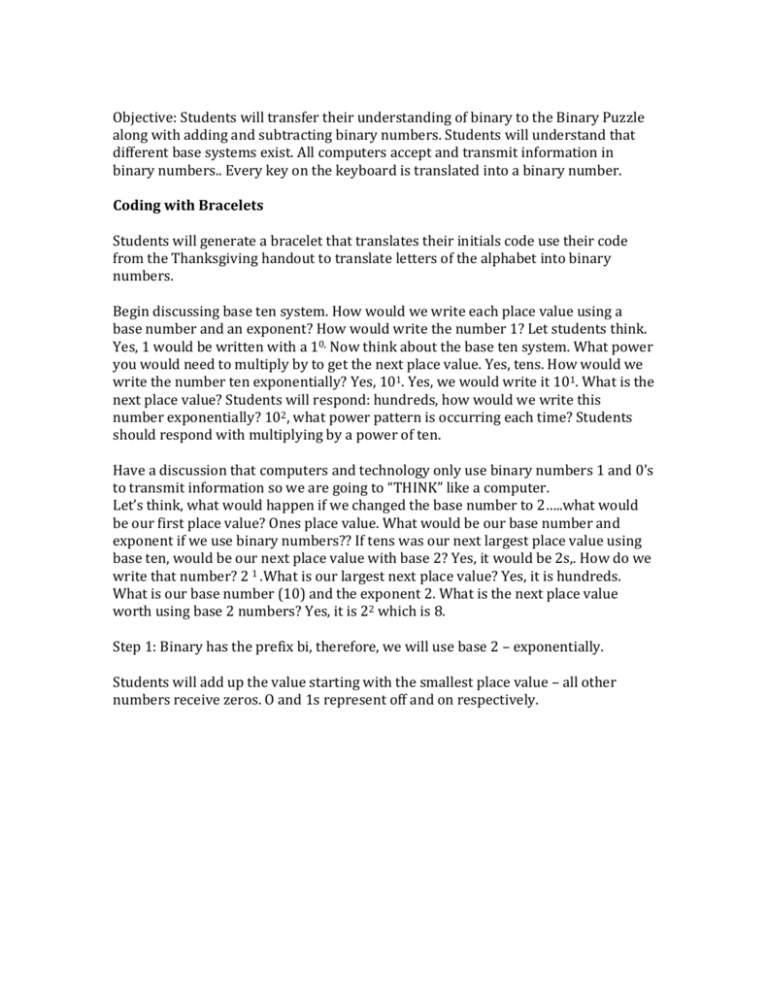File
advertisement

Objective: Students will transfer their understanding of binary to the Binary Puzzle along with adding and subtracting binary numbers. Students will understand that different base systems exist. All computers accept and transmit information in binary numbers.. Every key on the keyboard is translated into a binary number. Coding with Bracelets Students will generate a bracelet that translates their initials code use their code from the Thanksgiving handout to translate letters of the alphabet into binary numbers. Begin discussing base ten system. How would we write each place value using a base number and an exponent? How would write the number 1? Let students think. Yes, 1 would be written with a 10, Now think about the base ten system. What power you would need to multiply by to get the next place value. Yes, tens. How would we write the number ten exponentially? Yes, 101. Yes, we would write it 101. What is the next place value? Students will respond: hundreds, how would we write this number exponentially? 102, what power pattern is occurring each time? Students should respond with multiplying by a power of ten. Have a discussion that computers and technology only use binary numbers 1 and 0’s to transmit information so we are going to “THINK” like a computer. Let’s think, what would happen if we changed the base number to 2…..what would be our first place value? Ones place value. What would be our base number and exponent if we use binary numbers?? If tens was our next largest place value using base ten, would be our next place value with base 2? Yes, it would be 2s,. How do we write that number? 2 1 .What is our largest next place value? Yes, it is hundreds. What is our base number (10) and the exponent 2. What is the next place value worth using base 2 numbers? Yes, it is 22 which is 8. Step 1: Binary has the prefix bi, therefore, we will use base 2 – exponentially. Students will add up the value starting with the smallest place value – all other numbers receive zeros. O and 1s represent off and on respectively. BASE 10 104 PLACE VALUE 103 102 101 1000 100’s 10’s BASE 2 24 23 PLACE VALUE 16’s 8’s 22 4’s 21 2’s 100 *Our number system 1’s 20 1’s *Computer Number System Ask students what power is being multiplied in base 2? What power would be multiplied in base 5? So how do we translate base ten numbers into the binary system? Find the sum of the number by adding the place values of base 2. If you use a number from the column, then you will place a 1 in that column. If not, that digit will become a zero. 1 is on and a 0 is off. BASE 2 24 23 PLACE VALUE 16’s 8’s 22 4’s 21 2’s 20 1’s *Computer Number System ie 5 0 0 1 0 1 *(4+1) 16 1 0 0 0 0 *(16) 9 0 1 0 0 1 *(8+1) 3 0 0 0 1 1 A number is assigned to each letter of the alphabet. In our game. We are going to use that same data to make a binary bracelet. A = 1, B=2, C=3, D=4, E=5 So you will create a bracelet with 2 colors to represent your first and last initial of your name – predetermine on/off for each color before passing out the packs to your students. Ie Pink = On Lime Green = Off – allow for a separation bead which is a different color to be placed between your first and last initial. You will need 8 beads for each initial and one separation bead. Students will need to select their colors based on the number of 1 and 0’s generated by their initial. Ie – A would be LG, LG, LG, LG, LG, LG, LG, P 0 0 0 0 0 0 0 1 Another Idea: Make a binary with candy using licorice and cheerios. ©Tricia Betts & Mary Cummings





